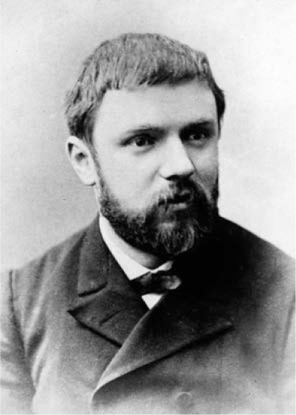VI.61 Jules Henri Poincaré
b. Nancy, France, 1854; d. Paris, 1912
Function theory; geometry; topology; celestial mechanics;
mathematical physics; foundations of science
Educated at the École Polytechnique and the École des Mines in Paris, Poincaré began his teaching career at the University of Caen in 1879. In 1881 he took up an appointment at the University of Paris where, from 1886, he held successive chairs until his death in 1912. He was of a retiring nature and did not attract graduate students, but his lecture courses provided the basis for a number of treatises, mostly in mathematical physics.
Poincaré came to international prominence in the early 1880s when, fusing ideas from complex function theory, group theory, non-Euclidean geometry, and the theory of ordinary linear differential equations, he identified an important class of automorphic functions. Named Fuchsian functions, in honor of the mathematician Lazarus Fuchs, they are defined on a disk and remain invariant under certain discrete groups of transformations. Soon after, he identified the related but more complicated Kleinian functions, which are automorphic functions without a limit circle. His theory of automorphic functions was the first significant application of non-Euclidean geometry. It led to his discovery of the disk model of the hyperbolic plane and later inspired the UNIFORMIZATION THEOREM [V.34].
Jules Henri Poincaré
During the same period Poincaré began pioneering work on the qualitative theory of differential equations, motivated in part by an interest in some of the fundamental questions of mechanics, notably the problem of the stability of the solar system. What was new and important was his idea of thinking of the solutions in terms of curves rather than functions, i.e., thinking geometrically rather than algebraically, and it was this that marked a departure from the work of his predecessors, whose research had been dominated by power-series methods. From the mid 1880s he began applying his geometric theory to problems in celestial mechanics. His memoir on THE THREE-BODY PROBLEM [V.33] (1890) is famous both for providing the basis for his acclaimed treatise, Les Méthodes Nouvelles de la Mécanique Céleste (1892-99), and for containing the first mathematical description of CHAOTIC BEHAVIOR [IV.14 §1.5] in a dynamical system. Stability was also at the heart of his investigation into the forms of rotating fluid masses (1885). This work, which contained the discovery of new, pear-shaped figures of equilibrium, aroused considerable attention because of its important implications for cosmogony in relation to the evolution of binary stars and other celestial bodies.
Poincaré’s work on Fuchsian functions and on the qualitative theory of differential equations led him to recognize the importance of the topology (or, as it was then called, analysis situs) of MANIFOLDS [I.3 §6.9]. And in the 1890s he began to study the topology of manifolds as a subject in its own right, effectively creating the powerful independent field of ALGEBRAIC TOPOLOGY [IV.6]. In a series of memoirs published between 1892 and 1904, the last of which contains the hypothesis known today as THE POINCARÉ CONJECTURE [IV.7 §2.4], he introduced a number of new ideas and concepts, including Betti numbers, THE FUNDAMENTAL GROUP [IV.6 §2], HOMOLOGY [IV.6 §4], and torsion.
A deep interest in physical problems lay behind Poincaré’s achievements in mathematical physics. His work in potential theory forms a bridge between that of Carl Neumann on boundary-value problems and that of FREDHOLM [VI.66] on integral equations. He introduced a technique known as the “méthode de balayage” (“sweeping-out method”) for establishing the existence of solutions to the DIRICHLET PROBLEM [IV.12 §1] (1890); and he had the idea that the Dirichlet problem itself should give rise to a sequence of EIGENVALUES AND EIGENFUNCTIONS [I.3 §4.3] (1898). In developing the theory for functions of several variables he was led to the discovery of new results in complex function theory. In Électricité et Optique (1890, revised 1901), which derived from his university lectures, he gave an authoritative account of the electromagnetic theories of Maxwell, Helmholtz, and Hertz. In 1905 he responded to Lorentz’s new theory of the electron, coming close to anticipating Einstein’s theory of SPECIAL RELATIVITY [IV.13 §1], thereby provoking controversy among later writers about the question of priority. And in 1911 he attended the first Solvay Conference on quantum theory, publishing an influential memoir (1912) in its favor.
As Poincaré’s career developed, so too did his interest in the philosophy of mathematics and science. His ideas became widely known through four books of essays: La Science et l’Hypothèse (1902), La Valeur de la Science (1905), Science et Méthode (1908), and Dernières Pensées (1913). As a philosopher of geometry he was a proponent of the view, known as conventionalism, that it is not an objective question which model of geometry best fits physical space but is rather a matter of which model we find most convenient. By contrast, his position on arithmetic was intuitionist. On the question of foundational issues, he was largely critical. Although sympathetic to the goals of set theory, he attacked what he perceived as its counterintuitive results. (See THE CRISIS IN THE FOUNDATIONS OF MATHEMATICS [II.7 §2.2] for further discussion.)
Poincaré’s visionary geometric style led him to new and brilliant ideas, which frequently connected different branches of mathematics, but lack of detail often made his work hard to follow. At times his approach was censured for imprecision; it was in marked contrast to that of HILBERT [VI.63], his German counterpart, whose work was rooted in algebra and rigor.
Further Reading
Barrow-Green, J. E. 1997. Poincaré and the Three Body Problem. Providence, RI: American Mathematical Society.
Poincaré, J. H. 1915-56. Collected Works: Œuvres de Henri Poincaré, eleven volumes. Paris: Gauthier Villars.

